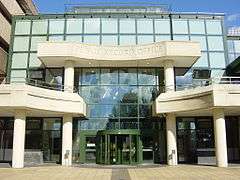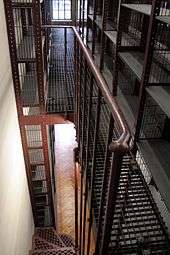Public Record Office
| Public Record Office | |
|---|---|
 Entrance of the Public Record Office on Chancery Lane, now the Maughan Library, King's College London | |
| General information | |
| Type | National archive |
| Architectural style | Neo-Gothic |
| Town or city | City of London, London |
| Country | United Kingdom |
| Coordinates | 51°30′55″N 0°06′38″W / 51.5153°N 0.1106°WCoordinates: 51°30′55″N 0°06′38″W / 51.5153°N 0.1106°W |
| Design and construction | |
| Architect | Sir James Pennethorne |
The Public Record Office (abbreviated as PRO, pronounced as three letters and referred to as the PRO) was the national archive service of the United Kingdom from 1838 until 2003, when it was merged with the Historical Manuscripts Commission to form The National Archives. The name Public Record Office is no longer in official use, though some researchers prefer it to avoid confusion with national archives of other countries.
The office was sometimes incorrectly referred to in the plural form, as the Public Records Office.
History

19th century
The Public Record Office was established in 1838, to reform the keeping of government and court records which were being held, sometimes in poor conditions, in a variety of places. Some of these were court or departmental archives (established for several centuries) which were well run and had good or adequate catalogues; others were little more than store-rooms. Many of the professional staff of these individual archives simply continued their existing work in the new institution. A good number of documents were transferred from the Tower of London and the chapter house of Westminster Abbey, though Domesday Book was not moved from Westminster until 1859, when proper storage had been prepared.
The PRO was placed under the control of the Master of the Rolls, a senior judge whose job had originally included responsibility for keeping the records of the Chancery Court, and was originally located in the mediaeval Rolls Chapel (the former Domus Conversorum, a chapel for Jews who had converted to Christianity), on Chancery Lane at the boundary of the City of London with Westminster. The first Master of the Rolls to take on this responsibility was Lord Langdale, while his Deputy Keeper, the historian Sir Francis Palgrave, had full-time responsibility for running the Office.

There was no right to consult the records freely for scholarly purposes until 1852, despite the 1838 Public Record Office Act's intention of enabling public access. Fees were paid by lawyers who used the archives to consult a limited number of documents. These charges were abolished for serious historical and literary researchers after a petition was signed in 1851 by 83 people including Charles Dickens, Lord Macaulay, and Thomas Carlyle.
A purpose built archive repository was designed and built between 1851 and 1858 (architect: Sir James Pennethorne) and extended onto the site of the Rolls Chapel, which was demolished as it was structurally unsound, between 1895 and 1902. Public search rooms were opened in 1866, but greater access led the authorities to restrict certain classes of document, and to favour visitors who were experienced in dealing with historical material.
20th century

The growing size of the archives held by the PRO and by government departments led to the Public Records Act 1958, which established standard procedures for the selection of documents of historical importance to be kept by the PRO. Even so, growing interest in the records produced a need for the Office to expand, and a second building was opened at Kew in south-west London in 1977. The Kew building was expanded in the 1990s and all records were transferred from Chancery Lane to Kew or the Family Records Centre in Islington by 1997. The Chancery Lane building was acquired by King's College London in 2001, and is now the Maughan Library, the university's largest library.
Merger with the Historical Manuscripts Commission
In April 2003 the PRO merged with the Historical Manuscripts Commission to form The National Archives, which moved from its previous office also located off Chancery Lane, to Kew in 2004. The National Archives of Scotland and the Public Record Office of Northern Ireland were and remain separate institutions.
Functions of the Office
The archive held the official collection of records of public business for England, Wales and the central UK government, including the records of court proceedings going back to the Middle Ages, and the original manuscript of the Domesday Book.
Public access
Under the 1958 act, most documents held by the PRO were kept "closed" (or secret) for 50 years: under an amending act of 1967 this period was reduced to 30 years (the so-called "thirty year rule"). These provisions changed significantly when the UK's Freedom of Information Act (2000) came into full effect in 2005: the 30 year rule was abolished and closed records in The National Archives became subject to the same access controls as other records of public authorities. Some records do remain closed for longer periods, however: individual census returns, for example, are kept closed for 100 years. In 2002 the PRO set up a website to allow online access to the records of the 1901 census, and was overwhelmed by the numbers of people wanting to access the site.
Deputy Keepers and Keepers
From 1838 to 1958 the nominal head of the office, known as the Keeper of the Records, was the Master of the Rolls of the day. The chief executive officer who oversaw the office's day-to-day operations was known as the Deputy Keeper of the Records. Deputy Keepers from 1838 to 1958 were:[1]
- 1838–1861: Sir Francis Palgrave
- 1861–1878: (Sir) Thomas Duffus Hardy
- 1878–1886: (Sir) William Hardy
- 1886–1926: (Sir) Henry Maxwell Lyte
- 1926–1938: Alfred Edward Stamp
- 1938–1947: (Sir) Cyril Thomas Flower
- 1947–1954: (Sir) Hilary Jenkinson
- 1954–1958: (Sir) David Lewis Evans
The 1958 act transferred responsibility for the PRO from the Master of the Rolls to the Lord Chancellor; and the title of the chief executive was changed to Keeper of Public Records. The Keepers from 1958 to 2003 were:
- 1958–1960: Sir David Lewis Evans[2]
- 1960–1966: Stephen Wilson
- 1966–1970: Harold Cottam Johnson[3]
- 1970–1978: Jeffery Raymond Ede[4]
- 1978–1982: Alfred Mabbs[5]
- 1982–1988: Geoffrey Martin[6]
- 1988–1991: Michael Roper
- 1991–2003: Sarah Tyacke (became Chief Executive of The National Archives, and retired 2005)[7]
References
- ↑ Cantwell 1991, pp. 569–70.
- ↑ Ede, J.R. (1987). "David Lewis Evans [obituary]". Journal of the Society of Archivists. 8 (4): 304–6.
- ↑ Latham, R.E. (1974). "Harold Cottam Johnson, 1903–1973 [obituary]". Archives. 11: 215–7.
- ↑ Chalmers, Duncan (23 December 2006). "Jeffery Ede: Keeper of Public Records [obituary]". The Independent. London. Retrieved 20 January 2013.
- ↑ "Alfred Mabbs [obituary]". Society of Antiquaries of London. Retrieved 20 January 2013.
- ↑ Jones, Michael; Crook, David. "Professor Geoffrey Martin, CBE (1928-2007)". Lincoln Record Society. Retrieved 20 January 2013.
- ↑ "Sarah Tyacke: Biography". Retrieved 6 February 2013.
Further reading
- Cantwell, John D. (1991). The Public Record Office, 1838-1958. London: HMSO. ISBN 0114402248.
- Cantwell, John D. (2000). The Public Record Office, 1959-1969. Richmond, Surrey: Public Record Office. ISBN 1873162758.
- Lawes, Aidan (1996). Chancery Lane: "The strong box of the Empire" [1377-1977]. Kew: PRO Publications. ISBN 978-1-873162354.
- Levine, Philippa (1986). The Amateur and the Professional: antiquarians, historians and archaeologists in Victorian England, 1838–1886. Cambridge: Cambridge University Press. ISBN 0-521-30635-3.
- Pike, Luke Owen (1907). The Public Records and The Constitution. London: Oxford University Press.